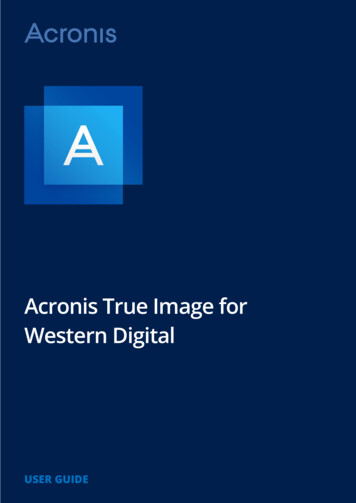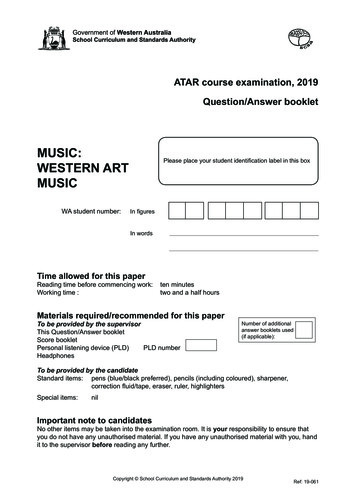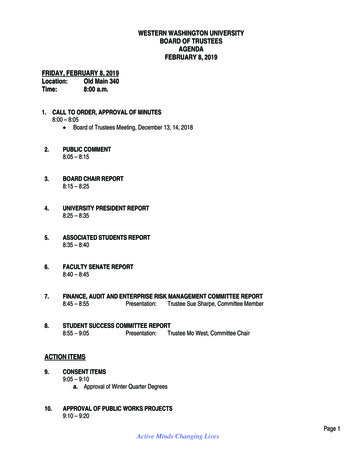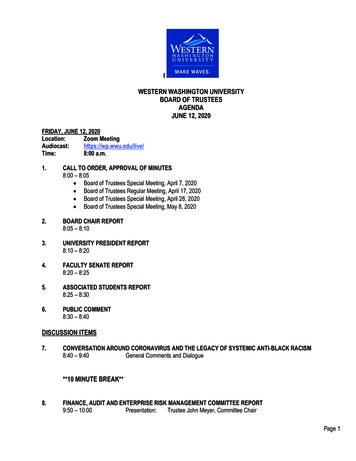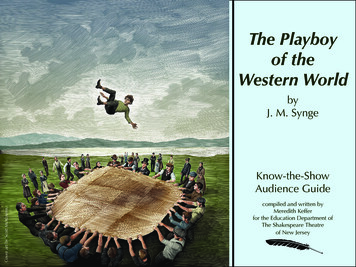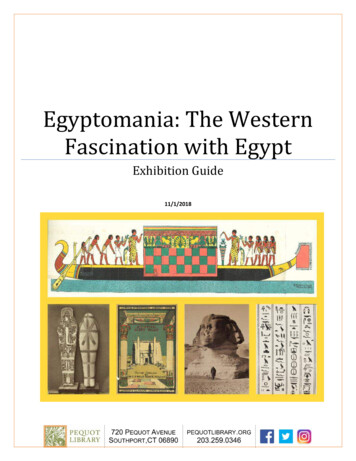
Transcription
Egyptomania: The WesternFascination with EgyptExhibition Guide11/1/2018
CONTENTSIntroduction . - 2 Discussion Topics . - 3 Vocabulary . - 4 Suggested Reading . - 6 Internet Resources . - 8 What is Egyptomania? . - 11 19th Century Tourism in Egypt . - 13 Travel Photography and Photogravure . - 14 Obelisks. - 27 Heritage Transported . - 21 Artifacts. - 30 Egyptomania in Culture. - 36 Book Descriptions . - 39 --1-
IntroductionEgypt has captivated western culture for millennia. When the Roman Empire reigned, Julius Caesar and MarcAntony were enthralled by the Egyptian queen, Cleopatra, an icon who has inspired countless plays, novels,and films. Egypt, in turn, has become evocative of the exotic, beautiful, and seductive. For westerners, Egyptholds a thrilling allure, but there is an air of exoticism that is too romantic to be realistic - and so it’s important toseparate fact from the fictional Egypt of the western imagination. Nonetheless, such perceptions havepersisted, and the fascination with Egypt thrives – Egyptomania.This western captivation was renewed in the early nineteenth century when Napoleon Bonaparte led acampaign through Egypt that yielded little military success, but ample scientific discovery. It was on thisexpedition that the Rosetta Stone was discovered, and many other artifacts were brought back to Europe,initiating a long pattern of instating Egyptian antiquities in foreign museums. Even ancient monuments likeobelisks were transported through expensive and dangerous ventures, winding up in cities like London, Parisand New York. Through these discoveries and undertakings, developments were made in archaeology, andthe field of Egyptology was established.This romance with Egypt was enhanced by the burgeoning technology of photography, which permitted visualimages of far-off locales without the need to embark on an elaborate journey. Simultaneously, tourism to theregion became all the rage for the well-to-do, and a trip around the world was incomplete without a cruise downthe Nile or a stop at the Sphinx. One of the founders of Pequot Library, Virginia Marquand Monroe, took such atrip in the winter of 1890-1891, developing a passion for Egypt. Featured in the cases are a number ofEgyptian artifacts she collected, along with a number of texts about Egypt that she acquired for the Library’scollection.Egyptomania has influenced our cultural identity through art, architecture, music, movies, and literature,growing even more in the 1920s, after the discovery of Tutankhamun’s tomb. Tombs and artifacts continue tobe uncovered today, stoking our fascination and encouraging us to look at Egyptomania and our own culture ina new light.-2-
Discussion Topics Why were people in the west fascinated with Egypt in the late 19th and early20th centuries? What did Egypt represent to them? Why did people travel to Egypt in the late 19th century? What did travelers see? How were their experiences with modern Egyptdifferent from romanticized ideas about the country that they may have had? Was the tourist experience isolated from local life? Who were touristssurrounded by? How did this affect their experience in Egypt? What role did 19th century photographers play in romanticizing Egypt forwesterners? Why would they do this? How did travelers in Egypt document their experiences? What do we have in common with the 19th century traveler, in terms of interestsand points of view about Egypt or other foreign lands? Do we seek familiarity inthe midst of the unfamiliar? Do we prefer to be isolated from local life, or do weseek to experience what life is truly like in these countries? In what ways did Egypt influence western architecture, art, literature,culture? What are some examples?-3-
VocabularyAncientOf, or belonging to, earliest known civilizations.ArtifactAnything made by human skill or work.ArchaeologyThe study of human history through the excavation of sites and the analysis of artifactsand other physical remains.Canopic JarJars used by Ancient Egyptians to hold mummified remains. During the mummificationprocess, the organs of the body were removed and preserved separately in canopic jars.EgyptologyThe study of the language, civilization, and history of Egypt.EgyptomaniaThe term Egyptomania, from Greek Egypto- ‘Egypt’ and mania ‘madness, fury’, refers tothe enthusiasm for everything that is related to ancient Egypt. Egyptian motifs have beenadopted throughout western visual culture including architecture and art.HieroglyphA picture, character, or symbol that represents a word, idea, or sound.MotifA decorative design or pattern.MummyA body of a human being or animal that has been ceremonially preserved by theremoval of internal organs and wrapped in bandages. Preserving a person, and in someinstances, animals, for the afterlife—was commonly practiced in ancient Egypt. Afterbodies were mummified, they were placed inside special cases that served to protect thebody.ObeliskA stone pillar, typically having a square or rectangular cross section and a pyramidal top,set up as a monument or landmark.PapyrusCommon Egyptian plant whose reeds were used to make a writing material similar topaper, also called papyrus.PharoahA ruler in ancient Egypt.PyramidThe Egyptian pyramids are ancient pyramid-shaped masonry structures located inEgypt. As of November 2008, sources cite either 118 or 138 as the number of identifiedEgyptian pyramids. Most were built as tombs for the country's pharaohs and theirconsorts during the Old and Middle Kingdom periods.(https://en.wikipedia.org/wiki/Egyptian pyramids)-4-
Rosetta StoneA stone with writing on it in two languages (Egyptian and Greek), using three scripts(hieroglyphic, demotic and Greek), found by French soldiers in 1799 near a smallEgyptian village called Rosetta. The Rosetta Stone made it possible to decipher ancientEgyptian hieroglyphics.SarcophagusA sarcophagus was a coffin made of stone, wood or paper that the Egyptians used tohouse the mummified remains of all types of people – not just the pharaohs. Sarcophagiwere covered with carvings or paintings depicting the person entombed, importantsymbols, and hieroglyphics, all which were to help the individual enter and peacefullyreside in the afterlife.ScarabA large beetle of the eastern Mediterranean area, regarded as sacred in ancient Egypt.SphinxIn Ancient Egypt, a figure of an imaginary creature having the head of a man oran animal and the body of a lion.TombAn excavation in earth or rock for the burial of a corpse; grave.A monument for housing or commemorating a deceased ian -5-
Suggested ReadingEarly Readers:dePaola, Tomie. Bill and Pete Go Down the Nile. (1987)Hartland, Jesse. How the Sphinx Got to the Museum. (2010)Krebs, Laurie. We’re Sailing Down the Nile. (2007)Rumford, James. Seeker of Knowledge: The Man Who Deciphered Egyptian Hieroglyphics. (2000)Schachner, Judy. Skippyjon Jones in Mummy Trouble. (2006)Middle Readers:Giblin Cross, James. The Riddle of the Rosetta Stone. (1993)Giblin Cross, James. Secrets of the Sphinx. (2004)Hart, George. DK Eyewitness: Ancient Egypt. (1988)McGraw, Eloise Jarvis. The Golden Goblet. (1986)Osborne, Mary Pope. Mummies in the Morning. (2006)Kennett, David. Pharoah: Life and Afterlife of a God. (2008)Payne, Elizabeth. The Pharoahs of Ancient Egypt. (1981)Sands, Emily. Egyptology: Uncovering the Tomb of Osiris. (2004)Stanley, Diane. Cleopatra. (1994)Van Vleet, Carmella. Great Ancient Egypt Projects You Can Build Yourself. (2006)Young Adults:Houck, Colleen. Reawakened. (2015)McGraw, Eloise Jarvis. Mara, Daughter of the Nile. (1985)Riordan, Rick. The Red Pyramid. (2010)Snyder, Zilpha Keatley. The Egypt Game. (2009)White, Kiersten. The Chaos of Stars. (2013)-6-
Adults:FictionThe Visitors, by Sally BeaumanThe Yacoubian Building, by Alaa Al AswanyThe Cairo Trilogy:Palace Walk, by Naguib MahfouzPalace of Desire, by Naguib MahfouzSugar Street, by Naguib MahfouzThe Heretic Queen, by Michelle MoranFlow Down Like Silver, by Ki LongfellowChronicle of a last summer, by Yasmine El RashidiMaryam's Maze, by Mansoura Ez EldinThe Map of Love, by Ahdaf SoueifThe Last Watchman of Old Cairo, by Michael David LukasPharaoh, by Wilbur A. SmithNon FictionEgyptomania, by Bob BrierCleopatra's Needles: The Lost Obelisks of Egypt, by Bob BrierThe Innocents Abroad, by Mark TwainEgyptian Mythology: A Guide to the Gods, Goddesses, and Traditions of Ancient Egypt, by Geraldine PinchThe Rise and Fall of Ancient Egypt, by Toby WilkinsonThe Discovery of the Tomb of Tutankhamen, by Howard CarterCleopatra: A Life, by Stacy SchiffRevolution 2.0, by Wael GhonimCircling the Square: Stories from the Egyptian Revolution, by Wendell SteavensonThe Woman who Would be King, by Kara Cooney-7-
Internet Resources1. hibit-13860454732. ns-et-desrecherches-qui-ont-t#/?tab utstomb/?user.testname nonehttps://www.youtube.com/watch?v dmkDPaHSBzg3. Ancient EgyptThe British Museum: http://www.ancientegypt.co.ukThe Smithsonian: https://www.si.edu/spotlight/ancient-egyptColor tour of Egypt: http://www.memphis.edu/egypt/resources/egypt.php4. 19th century European Tourism in EgyptHistory of Tourism in 1755182X.2012.711373?src recsys&journalCode mids/index.htmNile Cruise: http://timea.rice.edu/NileCruise.htmlThomas Cook Ltd: https://kbowenmysteries.com/posts/cooks-tour/19th c. Travel Writing: 18th-19th-century-travelwriting-8-
5. 19th Century Photographers and photographersPhotogravure: http://www.pbs.org/wgbh/roadshow/fts/memphis 200403A10.htmlOrientalism in Photography: hotography/6. Egyptian Revival Art and /hd erev.htmFrom Echoes of Egypt at the Peabody Egyptian Revival architectureArt e-of-egypt-on-art-deco-design/7. Egyptian Revival in Western ashion#18. Links related to artifacts in exhibitionShabti lls-the-workforce-in-the-afterlife/-9-
Kohl jIUOsiris ion/artifacts6.htmlMummy -case9. Links related to photos in exhibitionTemple erview/campfire-river-kiosk-trajan-philaeAbu pt10. Depictions of Egypt in 19th century -labour-lostOrientalism in 19th century art:https://www.metmuseum.org/toah/hd/euor/hd ptosophy/snake-charmer- 10 -
What is Egyptomania?Scientific discovery in Egypt between the late 18th and early 20th centuries sparked a surge of interest for allthings Egyptian in Europe and the United States. This fascination with Egypt inspired a wave of tourism to thecountry. It was also was expressed in western architecture, art, and culture through a variety of Egyptianinspired designs, or motifs. We call this enthusiasm related to ancient Egypt ures/what-is-egyptomania)What were some of the scientific discoveries that kindled Egyptomania? ¹Napoleon’s Expedition to EgyptNapoleon Bonaparte, Emperor of France, led a militaryexpedition to Egypt from 1798 to 1801 that created awave of Egyptomania across Europe. This is becausemany scientists accompanied him and recorded theremains of ancient Egyptian monuments – a type ofdocumentation that had never been done before.One of the most important discoveries during Napoleon’sexpedition was the Rosetta Stone, which his soldiersfound in 1799. In 1822, a French scholar andarchaeologist named Jean-François ChampollionBonaparte before the Sphinx by Jean-Léon Gérome, 1886deciphered hieroglyphs on the Rosetta Stone. Thiswas the beginning of the science of Egyptology.Check out this video to learn about the Rosetta Stone:https://www.youtube.com/watch?v yeQ-6eyMQ oThe Discovery of King Tut’s TombIn 1922, British archaeologists Howard Carter and Lord Carnarvondiscovered the tomb of Pharaoh Tutankhamun in ancient Egypt, causingEgyptomania to spread throughout the west again. In addition to thediscovery itself, the tale of the mummy’s curse, which supposedly killedLord Carnarvon in 1923, created a craze among those fascinated withEgypt.King Tut has been exhibited in museums around the world since the 1960s– keeping ‘Tutmania’ alive still today.Check out this video to learn about the discovery of King Tut’s tomb:https://www.youtube.com/watch?v Avqafc6fZwcCarter (left) in Funerary Chamber courtesyof https://www.nationalgeographic.com- 11 -
Experiencing Egypt through Art and ArchitectureAccording to Manon Schutz in her article “What isEgyptomania?”, few could afford to travel to Egypt duringthese peaks in Egyptomania. So, the only experience mostpeople had with the country and its mysteries was throughmemento photographs, literature, art, and architecture, mostof which represented exotic and romantic images of Egypt.Schutz explains, “Many popular stories about Egypt focus onthe search for immortality and eternal love. Egyptomaniaexpresses these longings visually through obelisks,sphinxes, pyramids, and other Egyptian motifs”. Theseimages are reflected in western architecture, art, and /what-is-egyptomania)Le Sphynx Armachis a Gizeh, P. Sebah,Turkish,active ca. 1823-1886Cover to My Sahara Rosesong book, 1919Tiffany & Co. ormolu and marble mantel set, c/ 1885.Courtesy of https://www.metmuseum.org/toah/works -ofart/68.97.4-.6/Luxour Cinema, Paris, built in 19211 Schutz, Manon. What is Egyptomania? National Trust UK. University of Oxford. gyptomania- 12 -
19th Century Tourism in EgyptTourism was founded and developed in Europe and North America during the second half of the 19th century,with Egypt being one of the first locations people traveled to outside Europe. Few could afford to travel toEgypt in person, and for those who could not, Egypt was experienced through memento photography,literature, art, and architecture. Virginia Marquand Monroe was fortunate enough to travel to Egypt in the late19th century. This exhibition features photographs and mementos she collected to document her journey, aswell as books about Egypt. We can surmise based on her extensive collection of photographs, artifacts, andbooks about Egypt that she, too, was taken by the Egyptomania of her day.According to Elvan Cobb in his article, “Taking Home the Pyramids, Andrew D. White, A Tourist in 19th-centuryEgypt”, Egyptian tourism catered to many different interests. “One could gain better health by spending thewinter in Egypt, visit architectural masterpieces – both ancient and modern - or experience the exotic “other”that westerners were conditioned to expect in Egyptian cities. These experience were usually managedthrough tourism, particularly through guidebooks and packaged x.html),One of the most famous tourism companies of the day wasThomas Cook & Son, Ltd. Anyone who has heard thephrase, “I’ll give you the Cook’s tour” is familiar with Cook’scompany, which is still in operation today.According to K.B. Owen in her article, “19th Century Tourism,A Cook’s Tour of Egypt”, Cook is credited with bringingtourism to the middle-class consumer through the medium ofpackaged tours. His first organized tour to Egypt was in1869, and included a trip to the opening of the Suez Canal.As is stated in the article, “The Nile Cruise, 1847 and 1897”from Travelers in the Middle East Archive (TIMEA), “In 1870,Thomas Cook & Son began offering steamboat tours up theNile that could be accomplished in twenty days to the FirstCataract and back. An additional week could be added tocover the area up to the Second Cataract (Cook 14-26)”.(TIMEA), http://timea.rice.eduThe article goes on to say, “For many nineteenth and earlytwentieth century travelers, a cruise along the Nile River wasthe centerpiece of a journey to Egypt.” Cook's tours focusedon key sites along the Nile, such as Abydos, Thebes, Philae,and Abu Simbel.- 13 -
Travel Photography and PhotogravurePhotographyIn 1850 the first photographs of Egypt were published in Europe. Over the following 50 years more than 250amateur and professional photographers from across Europe and the Ottoman Empire would visit the country.As the discipline, art, and technology of photography evolved throughout the 19th century, an influx of tourists inEgypt created a demand for souvenir photographs. Photography allowed the production of instant and precisecopies of ancient Egyptian reliefs that artists had labored for years to re-create. Tourists could now purchasephotographic print sets, similar to postcard books or coffee table books today, that included scenic highlights of theirtravels.Photographs of Egypt published in Europe encouraged not only tourism, but also foreign investment in the country.With the rise of Egyptology as an academic discipline, photographers began serving tourists and Egyptologists alike.As such, the emergence of Egyptology, the rise of tourism, and advancements in photography in the late 19thcentury became closely interwoven.PhotogravureThe photogravure process is one of the most effective methods ever developed to mass-produce large editions ofphotographs for fine art books and magazines. This photomechanical technique combines photography and etchingto make high-quality, ink-based photographic prints. The resulting photogravure, or heliogravure, is an image thatcombines the realistic detail of a photograph with the subtle range of whites, grays, and blacks associated with afine art print.Many fine art books such as Egypt. Heliogravures After Original Views by R.M. Junghaendel, 1893, utilized themethod in the late 19th and early 20th centuries to make foreign destinations more accessible to the armchairtraveler.Orientalism in PhotographyNineteenth-century tourist photography not only included landscapes and images of historical monuments, but alsoscenes that catered to Western ideas of contemporary Egyptian life. As such, photographers often posed models ofmusicians, craftsmen, merchants, and other local people to match, and therefore reinforce, Western perspectives. Inher article, “Orientalism in Photography,” author Michelle L. Woodward states, “Nissan N. Perez in his book FocusEast: Early Photography in the Near East (1839-1885), succinctly explains one way of thinking about howOrientalism operates: “Literature, painting, and photography fit the real Orient into the imaginary or mental moldexisting in the Westerner’s mind. These attitudes are mirrored in many of the photographs taken during this time[the nineteenth century] Either staged or carefully selected from a large array of possibilities, they become livingvisual documents to prove an imaginary reality.”¹¹Nissan N. Perez, Focus East: Early Photography in the Near East (183901885), New York: Harry N. Abrams, Inc. in association withThe Domino Press, Jerusalem, and The Israel Museum, Jerusalem 1988, 50. hotography/)- 14 -
General view of CairoHeliogravureEgypt. Heliogravures After Original Viewsby R.M. Junghaendel, with a preface by C.G. RawlinsonBerlin: Cosmos Art Publishing Co. Ltd., 1893The panorama of the ‘well-protected city’, as the Egyptians have called their capital, leaves an indelible impressionon the memory of all travelers who have visited the historical valley of the Nile. From this vantage point, the 19 thcentury traveler’s eye would have wandered over an endless sea of houses, from which arise the slender, gracefulminarets of the mosques, until settling on the world-famed Pyramids of Giza ascending into the sky.Dancing Girl at KenehHeliogravureEgypt. Heliogravures After Original Viewsby R.M. Junghaendel, with a preface by C.G. RawlinsonBerlin: Cosmos Art Publishing Co. Ltd., 1893This plate represents a scene 19th-century travelers may have encountered while visiting a local café. Covered fromhead to waist in gold and silver spangles is Fatima, the dancing girl, captivating her audience with a performance ofthe ‘danse du ventre’ or belly dance. The musicians, her nearest relatives, play instruments including a clay drum.The audience, consisting principally of sailors, donkey-drivers, laborers, and other distinguished local residents,seem enchanted by the performance and clap their hands to follow the rhythm of the music and the movement ofthe dance. Such a performance in Egypt is called a “Fantasia.”- 15 -
Pyramids of GizehHeliogravureEgypt. Heliogravures After Original Viewsby R.M. Junghaendel, with a preface by C.G. RawlinsonBerlin: Cosmos Art Publishing Co. Ltd., 1893In The Innocents Abroad, Mark Twain describes the feeling of coming across the Egyptian pyramids for the firsttime: "At the distance of a few miles the Pyramids rising above the palms looked very clean-cut, very grandimposing, and very soft and filmy, as well. They swam in a rich haze that took from them all suggestions of unfeelingstone, and made them seem only the airy nothings of a dream." (Mart Twain, The Innocents Abroad, 1869).No. 46 Le Sphynx Armachis a GizehTranslation: The Sphinx Armachis at GizaAlbumen printArtist: P. Sebah, Turkish, active ca. 1823-1886"The Sphinx is grand in its loneliness; it is imposing in its magnitude; it is impressive in the mystery that hangs overits story. And there is that in the over-shadowing majesty of this eternal figure of stone, with its accusing memory of- 16 -
the deeds of all ages, which reveals to one something of what he shall find when he shall stand at last in the awfulpresence of God," (Mark Twain, The Innocents Abroad, 1869).Facing directly from west to east, the Great Sphinx of Giza is the oldest known monumental sculpture in Egypt.149. Chameliers du SinaiTranslation: Camel Drivers in SinaiAlbumen printArtist: P. Sebah, Turkish, active ca. 1823-1886Nineteenth-century tourist photography not only included landscapes and depictions of historical monuments, butalso scenes that fulfilled Western fantasies of the “exotic” lifestyles of regional peoples. Photographers created theirtableaux by posing models of musicians, craftsmen, merchants, and other local people. Here, Bedouin camel driversare depicted traversing the Nile in traditional dress.One of the Steamers of Thos. Cook & Son, (Egypt) Ltd.HeliogravureEgypt. Heliogravures After Original Viewsby R.M. Junghaendel, with a preface by C.G. RawlinsonBerlin: Cosmos Art Publishing Co. Ltd., 1893- 17 -
In 1870 Thomas Cook & Son began offering steamboat tours up the Nile River, to the First Cataract and back, thatcould be accomplished in 20 days. For many 19th-and early-20th- century travelers, a cruise along the Nile was thecenterpiece of a journey to Egypt. Cook's tours focused on key sites along the river, such as Abydos, Thebes,Philae, and Abu Simbel.Great Temple at KarnakHeliogravureEgypt. Heliogravures After Original Viewsby R.M. Junghaendel, with a preface by C.G. RawlinsonBerlin: Cosmos Art Publishing Co. Ltd., 1893The most wonderful portion of the mighty sanctuary dedicated to Egyptian god Ammon is, without a doubt, thegigantic hall beyond the second pylon. The building was begun under Seti I and completed by his son andsuccessor, Ramesses II. The succeeding rulers of the dynasty added pictorial representations and inscriptions,completing an incomparably beautiful monument from one of the most glorious epochs in Egyptian history. Althoughmany of them have collapsed or been scattered by the effects of both man and nature, the hall continues to providethe traveler with an overwhelming effect. This picture gives a view of the collapsed western hall of the second pylon.- 18 -
Colosse de Memmon. Vue d’EstAlbumen printArtist: P. Sebah, Turkish, active ca. 1823-1886On the western bank of the Nile, opposite Luxor, sit the Colossi of Memnon, a pair of monumental statuesrepresenting Amenhotep III (1386-1353 BCE). Ancient Greek writers referred to the entire complex regularly asthe Memnonium, after the Greek hero Memnon. In The Nile: Notes for Travellers in Egypt (published 1890), authorE.A. Budge notes that the site became a legendary oracle for Romans after an earthquake in 29 BCE damaged themonument, and it began “singing.” He notes inscriptions on the statues made by “distinguished Romans” whotraveled to the site, to hear the “vocal Memnon.”Valley of the Tombs of the King of ThebesHeliogravureEgypt. Heliogravures After Original Viewsby R.M. Junghaendel, with a preface by C.G. RawlinsonBerlin: Cosmos Art Publishing Co. Ltd., 1893About 3 miles from the left bank of the Nile, an old royal highroad takes the traveler between hills of ruins and steeprocky walls, to the Valley of the Kings in the old Theban capital. This plate offers a striking representation of theloneliness and desolation of the valley, which early travelers would have experienced. The dark, door-like openingsat the foot of the rocks represent the entrances to the royal catacombs. On the right are six openings, the first three- 19 -
of which lead respectively to the tombs of Ramesses II, Seti I, and Ramesses X. The three others lead to the tombsof other royalty.Temple of Isis at PhilaeHeliogravureEgypt.
Nov 01, 2018 · Great Ancient Egypt Projects You Can Build Yourself. (2006) Young Adults: Houck, Colleen. Reawakened. (2015) McGraw, Eloise Jarvis. Mara, Daughter of the Nile. (1985) Riordan, Rick. The Red Pyramid. (2010) Snyder, Zilpha Keatley. The Egypt Game
